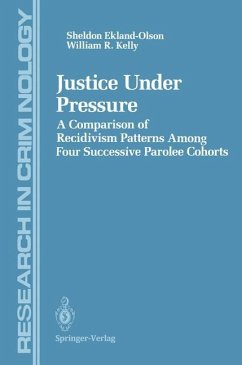Sheldon Ekland-Olson, William R. KellyA Comparison of Recidivism Patterns Among Four Successive Parolee Cohorts
Justice Under Pressure
A Comparison of Recidivism Patterns Among Four Successive Parolee Cohorts
Mitarbeit: Joo, H.-J.; Olbrich, J.; Eisenberg, M.
Sheldon Ekland-Olson, William R. KellyA Comparison of Recidivism Patterns Among Four Successive Parolee Cohorts
Justice Under Pressure
A Comparison of Recidivism Patterns Among Four Successive Parolee Cohorts
Mitarbeit: Joo, H.-J.; Olbrich, J.; Eisenberg, M.
- Broschiertes Buch
- Merkliste
- Auf die Merkliste
- Bewerten Bewerten
- Teilen
- Produkt teilen
- Produkterinnerung
- Produkterinnerung
Justice Under Pressure analyzes the effects of prison crowding on the justice system. The authors focus on dramatic changes in the administration of criminal justice in Texas during the 1980s and the influence of those changes on the three-year survival rates among parolees released between 1984 and 1987. Setting out to identify differences in recidivism and the crime rate as a result of the changes instituted in Texas, the authors report the findings of their comparative "survival analysis" of 4 successive cohorts of parolees, plus a chapter specifically directed at a comparative analysis of…mehr
Andere Kunden interessierten sich auch für
![Justice Under Pressure Justice Under Pressure]() Sheldon Ekland-OlsonJustice Under Pressure111,99 €
Sheldon Ekland-OlsonJustice Under Pressure111,99 €![Developments in Crime and Crime Control Research Developments in Crime and Crime Control Research]() Developments in Crime and Crime Control Research39,99 €
Developments in Crime and Crime Control Research39,99 €![Policing and Punishing the Drinking Driver Policing and Punishing the Drinking Driver]() Ross HomelPolicing and Punishing the Drinking Driver92,99 €
Ross HomelPolicing and Punishing the Drinking Driver92,99 €![Deterrence and Juvenile Crime Deterrence and Juvenile Crime]() Anne L. SchneiderDeterrence and Juvenile Crime39,99 €
Anne L. SchneiderDeterrence and Juvenile Crime39,99 €![The Social Contexts of Criminal Sentencing The Social Contexts of Criminal Sentencing]() Martha A. MyersThe Social Contexts of Criminal Sentencing39,99 €
Martha A. MyersThe Social Contexts of Criminal Sentencing39,99 €![Psychopathy Psychopathy]() D.J. Cooke / Adelle E. Forth / Robert D. Hare (Hgg.)Psychopathy420,99 €
D.J. Cooke / Adelle E. Forth / Robert D. Hare (Hgg.)Psychopathy420,99 €![Predicting Recidivism Using Survival Models Predicting Recidivism Using Survival Models]() Peter SchmidtPredicting Recidivism Using Survival Models77,99 €
Peter SchmidtPredicting Recidivism Using Survival Models77,99 €-
-
-
Justice Under Pressure analyzes the effects of prison crowding on the justice system. The authors focus on dramatic changes in the administration of criminal justice in Texas during the 1980s and the influence of those changes on the three-year survival rates among parolees released between 1984 and 1987. Setting out to identify differences in recidivism and the crime rate as a result of the changes instituted in Texas, the authors report the findings of their comparative "survival analysis" of 4 successive cohorts of parolees, plus a chapter specifically directed at a comparative analysis of an emergency release cohort. The final chapter compares prison construction policies and crime rate trends in Texas and California to highlight the major policy implications of the findings. This book is of particular interest to criminologists, forensic psychologists, forensic psychiatrists, and students in these fields.
Produktdetails
- Produktdetails
- Research in Criminology
- Verlag: Springer / Springer New York / Springer, Berlin
- Artikelnr. des Verlages: 978-1-4613-9519-5
- Softcover reprint of the original 1st edition 1993
- Seitenzahl: 156
- Erscheinungstermin: 9. Februar 2012
- Englisch
- Abmessung: 235mm x 155mm x 9mm
- Gewicht: 248g
- ISBN-13: 9781461395195
- ISBN-10: 1461395194
- Artikelnr.: 36119018
- Herstellerkennzeichnung
- Springer-Verlag GmbH
- Tiergartenstr. 17
- 69121 Heidelberg
- ProductSafety@springernature.com
- Research in Criminology
- Verlag: Springer / Springer New York / Springer, Berlin
- Artikelnr. des Verlages: 978-1-4613-9519-5
- Softcover reprint of the original 1st edition 1993
- Seitenzahl: 156
- Erscheinungstermin: 9. Februar 2012
- Englisch
- Abmessung: 235mm x 155mm x 9mm
- Gewicht: 248g
- ISBN-13: 9781461395195
- ISBN-10: 1461395194
- Artikelnr.: 36119018
- Herstellerkennzeichnung
- Springer-Verlag GmbH
- Tiergartenstr. 17
- 69121 Heidelberg
- ProductSafety@springernature.com
1 National Trends and the Assessment of Prison Crowding.- National Tends-1975 through 1989.- A Sea-Change in Prisoner Rights.- Assessing the Impact of Litigated Prison Reform.- 2 Population, Political, and Judicial Pressures on the Texas Criminal Justice System.- The Texas Prison Crowding Crisis.- Pressure from the Media.- Pressure from the Federal Court.- The Legislative Response.- Pressure Moves to the Parole System.- The Legislature Restructures the Criminal Justice System.- The Study Design.- 3 Intra-Cohort Variation in Reincarceration.- Characteristics of the Pooled 1984 and 1985 Cohorts.- Reincarceration Offense Patterns.- Conclusion.- 4 Inter-Cohort Comparisons of Reincarceration Rates.- Trends in Reincarceration.- Correlates of Recidivism across Cohorts.- Conclusion.- 5 Multivariate Prediction of Reincarceration.- Analysis of Parole Outcome.- Data and Model Fitting.- Analysis of Survival Time.- Conclusion.- 6 An Evaluation of the Legislative Response: The Prison Management Act.- Background of the Prison Management Act.- Operation of the Prison Management Act.- Data and Methods.- Results.- Conclusion.- 7 Incarceration and Crime: Is There a Link?.- Incarceration and Crime.- National and Two-State Comparisons.- Alternative Explanations for Varying Trends in California and Texas.- Conclusion.- 8 Conclusions and Policy Implications.- The Back-Door Solution: Parole Release.- The Front Door Solution: Intermediate Sanctions.- Increasing Prison Capacity.- Appendix A: Salient Factor Score.- Appendix B: Texas Board of Pardons and Paroles (BPP) Regions.- References.
1 National Trends and the Assessment of Prison Crowding.- National Tends 1975 through 1989.- A Sea-Change in Prisoner Rights.- Assessing the Impact of Litigated Prison Reform.- 2 Population, Political, and Judicial Pressures on the Texas Criminal Justice System.- The Texas Prison Crowding Crisis.- Pressure from the Media.- Pressure from the Federal Court.- The Legislative Response.- Pressure Moves to the Parole System.- The Legislature Restructures the Criminal Justice System.- The Study Design.- 3 Intra-Cohort Variation in Reincarceration.- Characteristics of the Pooled 1984 and 1985 Cohorts.- Reincarceration Offense Patterns.- Conclusion.- 4 Inter-Cohort Comparisons of Reincarceration Rates.- Trends in Reincarceration.- Correlates of Recidivism across Cohorts.- Conclusion.- 5 Multivariate Prediction of Reincarceration.- Analysis of Parole Outcome.- Data and Model Fitting.- Analysis of Survival Time.- Conclusion.- 6 An Evaluation of the Legislative Response: The Prison Management Act.- Background of the Prison Management Act.- Operation of the Prison Management Act.- Data and Methods.- Results.- Conclusion.- 7 Incarceration and Crime: Is There a Link?.- Incarceration and Crime.- National and Two-State Comparisons.- Alternative Explanations for Varying Trends in California and Texas.- Conclusion.- 8 Conclusions and Policy Implications.- The Back-Door Solution: Parole Release.- The Front Door Solution: Intermediate Sanctions.- Increasing Prison Capacity.- Appendix A: Salient Factor Score.- Appendix B: Texas Board of Pardons and Paroles (BPP) Regions.- References.
1 National Trends and the Assessment of Prison Crowding.- National Tends-1975 through 1989.- A Sea-Change in Prisoner Rights.- Assessing the Impact of Litigated Prison Reform.- 2 Population, Political, and Judicial Pressures on the Texas Criminal Justice System.- The Texas Prison Crowding Crisis.- Pressure from the Media.- Pressure from the Federal Court.- The Legislative Response.- Pressure Moves to the Parole System.- The Legislature Restructures the Criminal Justice System.- The Study Design.- 3 Intra-Cohort Variation in Reincarceration.- Characteristics of the Pooled 1984 and 1985 Cohorts.- Reincarceration Offense Patterns.- Conclusion.- 4 Inter-Cohort Comparisons of Reincarceration Rates.- Trends in Reincarceration.- Correlates of Recidivism across Cohorts.- Conclusion.- 5 Multivariate Prediction of Reincarceration.- Analysis of Parole Outcome.- Data and Model Fitting.- Analysis of Survival Time.- Conclusion.- 6 An Evaluation of the Legislative Response: The Prison Management Act.- Background of the Prison Management Act.- Operation of the Prison Management Act.- Data and Methods.- Results.- Conclusion.- 7 Incarceration and Crime: Is There a Link?.- Incarceration and Crime.- National and Two-State Comparisons.- Alternative Explanations for Varying Trends in California and Texas.- Conclusion.- 8 Conclusions and Policy Implications.- The Back-Door Solution: Parole Release.- The Front Door Solution: Intermediate Sanctions.- Increasing Prison Capacity.- Appendix A: Salient Factor Score.- Appendix B: Texas Board of Pardons and Paroles (BPP) Regions.- References.
1 National Trends and the Assessment of Prison Crowding.- National Tends 1975 through 1989.- A Sea-Change in Prisoner Rights.- Assessing the Impact of Litigated Prison Reform.- 2 Population, Political, and Judicial Pressures on the Texas Criminal Justice System.- The Texas Prison Crowding Crisis.- Pressure from the Media.- Pressure from the Federal Court.- The Legislative Response.- Pressure Moves to the Parole System.- The Legislature Restructures the Criminal Justice System.- The Study Design.- 3 Intra-Cohort Variation in Reincarceration.- Characteristics of the Pooled 1984 and 1985 Cohorts.- Reincarceration Offense Patterns.- Conclusion.- 4 Inter-Cohort Comparisons of Reincarceration Rates.- Trends in Reincarceration.- Correlates of Recidivism across Cohorts.- Conclusion.- 5 Multivariate Prediction of Reincarceration.- Analysis of Parole Outcome.- Data and Model Fitting.- Analysis of Survival Time.- Conclusion.- 6 An Evaluation of the Legislative Response: The Prison Management Act.- Background of the Prison Management Act.- Operation of the Prison Management Act.- Data and Methods.- Results.- Conclusion.- 7 Incarceration and Crime: Is There a Link?.- Incarceration and Crime.- National and Two-State Comparisons.- Alternative Explanations for Varying Trends in California and Texas.- Conclusion.- 8 Conclusions and Policy Implications.- The Back-Door Solution: Parole Release.- The Front Door Solution: Intermediate Sanctions.- Increasing Prison Capacity.- Appendix A: Salient Factor Score.- Appendix B: Texas Board of Pardons and Paroles (BPP) Regions.- References.









